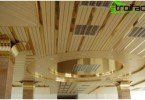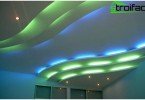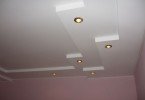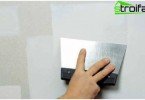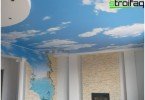DIY ceiling decor
There are many ways to equip the ceiling, the use of one or another is largely due to external factors (height, size of the room, conditions for further operation). But the technique of execution is just a means. And the goal of any repair is to refresh, decorate, transform, make your home special and cozy. Seek help from specialists or implement ideas on your own? – The answer depends on the level of your training and on the desired effect. We will consider the possible decoration options, dwelling in more detail on the finishing methods available to the majority in terms of complexity and not requiring the use of expensive highly specialized equipment. So, the subject of scrutiny today is the ceiling decor with your own hands..
Content
- Decoration of the ceiling with textured plaster
- Decoration of the ceiling with imitation of stucco molding
- Decor of a ceiling polystyrene plates
- Hanging ceiling decoration
- Some design tips
Let’s take a closer look at the ceiling. We are primarily interested in its size, shape, the possibility of arranging additional lighting, as well as how the walls are connected to the ceiling (at an angle or with rounding). Another important point – the presence of attachments, low-aesthetic protrusions, displacement of flow plates – if desired, they can be hidden behind a hinged structure made of drywall.
If changing the shape of the ceiling is not part of your plans and the main task remains to give the horizontal plane a special gloss, then you can either paint the ceiling in a new way, or glue it first with wallpaper (texture) and then paint it. There is another option, quite simple in execution and fascinating, it consists in applying textured plaster to the ceiling surface.
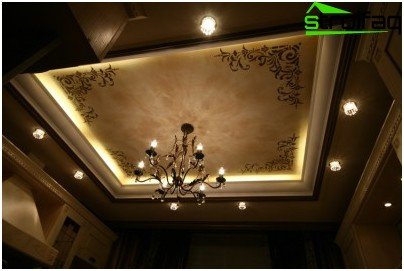
An example of a ceiling decor with textured plaster, followed by tinting and drawing a pattern using a stencil
Decoration of the ceiling with textured plaster
Using decorative plaster, you can achieve an interesting texture of the ceiling. Distinguish structural plaster – tinting in various shades is possible, it is supplied initially white, the master forms a relief using various rollers, scallops, various spatulas and brushes after applying the plaster in an even layer, as well as textured. Textured plaster is distinguished by the ability to form a relief after application without outside interference.
The composition of decorative plaster, in addition to filler (quartz, granite, marble chips) includes various thickeners, antiseptics, binders based on water (more environmentally friendly) and on the basis of solvents (wear-resistant). For the ceiling, it is better to use water-based plaster. You can get a different relief and surface pattern, using decorative plasters with different sized fillers. The resulting surface will be seamless (natural). An important point: fragmentary restoration of the coating is possible, but a large “patch” will be noticeable against the general background. The resulting textured surface can be painted. Dispersion paints are suitable for water-based plasters..
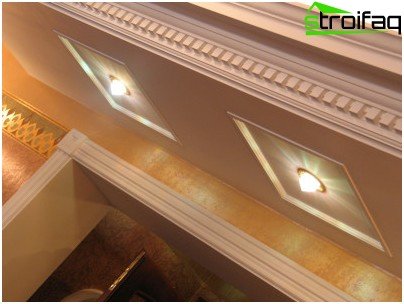
Decorating the ceiling with moldings and sockets made of polyurethane
Decoration of the ceiling with imitation of stucco molding
Gypsum stucco decorated the palaces before, if you decided to equip your nest in a palace or antique style, then imitation of stucco work is indispensable. Light in weight, easy to install and, importantly, moisture-resistant decorative elements made of polyurethane are durable, durable, do not turn yellow in the sun. Molded products are formed from foamed plastic, then “baked” in special ovens. Among other elements, cornices, sockets, floral arrangements, various decorative borders, pelasters. Moldings are especially popular – smooth or embossed decorative trims, they are often used to decorate the joints of the wall and ceiling.
Even in the manufacturing process, the moldings are primed, which allows further staining (with the exception of nitro-paints), gilding. The molding, contrasting with the color of the walls, visually makes the ceiling lower, the walls painted in the color of the visually merge, but the contrast of the shape visually raises the ceiling. Polyurethane moldings can be flexible, which allows decoration of curved structures.
Such decor is attached (to the ceiling or to the wall) with ordinary universal glue. Another polyurethane miracle is the ceiling domes. A decorative element made of plastic and thickened polyurethane will help to decorate the ceiling in antique or Gothic style. The decor is installed in a drywall design. It is glued using liquid nails or special glue. The most massive structures are fastened with self-tapping screws. Ceiling sockets are used to decorate the space around the lamp. Stylistics, ornament, form – can be very different.
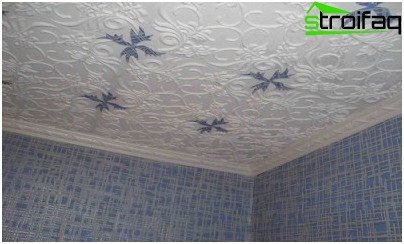
An example of decorating ceiling tiles with an application
Decor of a ceiling polystyrene plates
Expanded polystyrene ceiling tiles – smooth, embossed, imitating stucco molding or even wood, marble (covered with a special film). They are glued to the main ceiling, forming a flat surface. They help to hide cracks at the joints of slabs, but they are not able to hide significant irregularities in concrete floors.
The size of such plates is 500×500 mm, they are distinguished by injection (9-14 mm thick, with clear lines formed by pressing during sintering of expanded polystyrene), pressed (made from polystyrene blocks, their thickness is 5-8 mm) and extruded (thin, only 3 mm, but the most durable due to the compression of expanded polystyrene coated with a special film). Pressed tiles can subsequently be painted with acrylic or water-based paint. For rooms with high humidity it is better not to use.
Injection is somewhat stronger, the picture is clearly visible, it can also be painted, it is easy to achieve the effect of a seamless ceiling (the edges of the tile are very clear). Extruded tile is attractive because it can be used in rooms with high humidity. Glue ceiling can be recommended for small rooms – the height of the room does not decrease. The only limitation is the choice of tile pattern. But more on that later. The main disadvantage of this type of decor is its fragility, in addition, expanded polystyrene is a low-melting material, consider when placing fixtures.
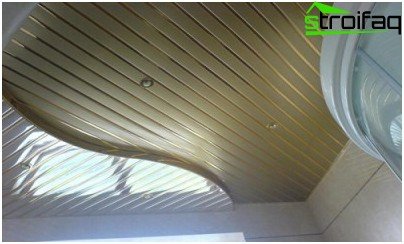
Hanging ceiling decoration
Hanging ceiling decoration
The suspension structure of a metal profile and drywall sheets or various modular elements (plates, battens, cassettes, panels) will help to hide the unevenness of the ceiling. The hollow space between the main ceiling and the suspended structure can be effectively used: for laying various communications and for installing fixtures.
Modular suspended ceilings are easily and quickly installed, access to communications is possible both local and over the entire surface – it depends on the design scheme and the type of modular element. But the arrangement of a suspended ceiling made of drywall will require some effort and accuracy of calculations.
Some design tips
Whatever decoration method you choose, try to follow the following recommendations: for a ceiling in a small room, a smooth surface is preferable to a textured one, gloss or mother of pearl is desirable, a small pattern is preferable to a large one. Light and cool shades of color visually add volume, warm, saturated, bright – on the contrary. When decorating the ceiling in a spacious room, stucco molding, various drywall constructions, the use of coarse decorative plaster are appropriate.


